GEEKOM AS 6 (ASUS PN53) Review: Ryzen 9 6900HX Packs Punches in a Petite Package
by Ganesh T S on July 31, 2023 8:00 AM ESTSystem Performance: Multi-Tasking
One of the key drivers of advancements in computing systems is multi-tasking. On mobile devices, this is quite lightweight - cases such as background email checks while the user is playing a mobile game are quite common. Towards optimizing user experience in those types of scenarios, mobile SoC manufacturers started integrating heterogenous CPU cores - some with high performance for demanding workloads, while others were frugal in terms of both power consumption / die area and performance. This trend is now slowly making its way into the desktop PC space.
Multi-tasking in typical PC usage is much more demanding compared to phones and tablets. Desktop OSes allow users to launch and utilize a large number of demanding programs simultaneously. Responsiveness is dictated largely by the OS scheduler allowing different tasks to move to the background. The processor is required to work closely with the OS thread scheduler to optimize performance in these cases. Keeping these aspects in mind, the evaluation of multi-tasking performance is an interesting subject to tackle.
We have augmented our systems benchmarking suite to quantitatively analyze the multi-tasking performance of various platforms. The evaluation involves triggering a ffmpeg transcoding task to transform 1716 3840x1714 frames encoded as a 24fps AVC video (Blender Project's 'Tears of Steel' 4K version) into a 1080p HEVC version in a loop. The transcoding rate is monitored continuously. One complete transcoding pass is allowed to complete before starting the first multi-tasking workload - the PCMark 10 Extended bench suite. A comparative view of the PCMark 10 scores for various scenarios is presented in the graphs below. Also available for concurrent viewing are scores in the normal case where the benchmark was processed without any concurrent load, and a graph presenting the loss in performance.
| UL PCMark 10 Load Testing - Digital Content Creation Scores | |||

| UL PCMark 10 Load Testing - Productivity Scores | |||
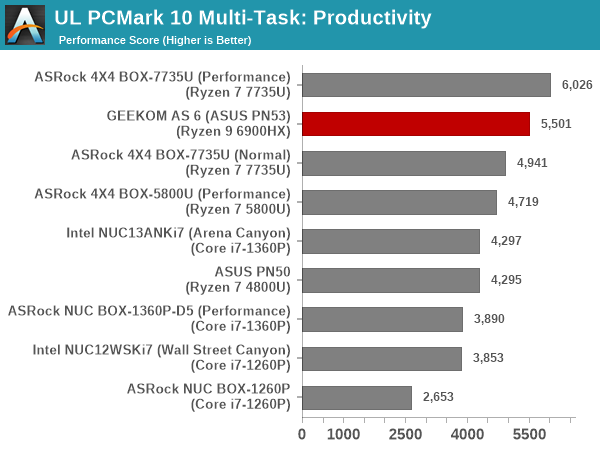
| UL PCMark 10 Load Testing - Essentials Scores | |||
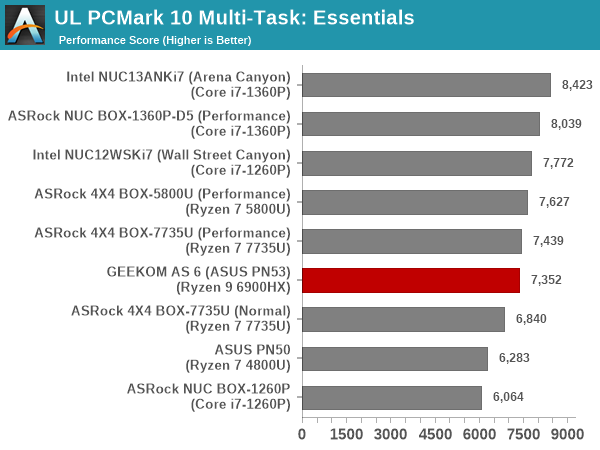
| UL PCMark 10 Load Testing - Gaming Scores | |||
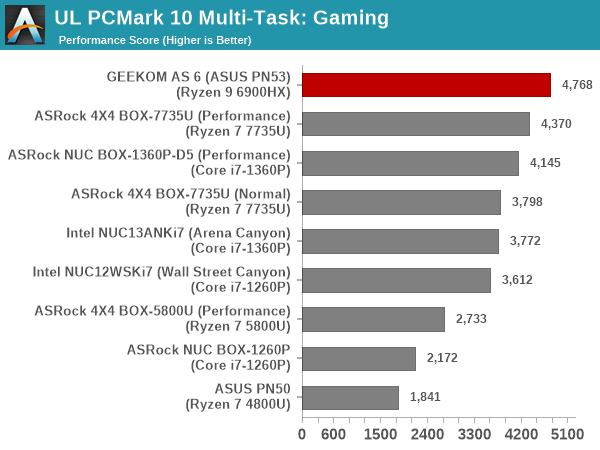
| UL PCMark 10 Load Testing - Overall Scores | |||
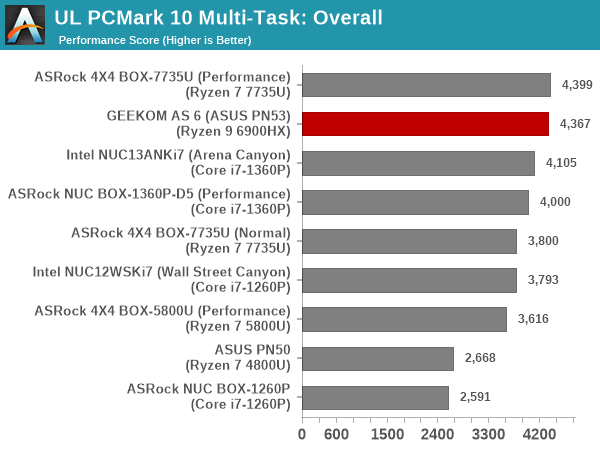
The gaming section comes to the rescue of the Rembrandt systems, allowing them to retain the top two spots in the overall scores. However, we see some benefits to the hybrid architecture in RPL-P as the introduction of concurrent loading tends to bog down the Rembrandt systems much more in the sub-components. The end result is that the RPL-P systems move to the top and push the Rembrandt systems down in the presence of intensive background tasks.
Following the completion of the PCMark 10 benchmark, a short delay is introduced prior to the processing of Principled Technologies WebXPRT4 on MS Edge. Similar to the PCMark 10 results presentation, the graph below show the scores recorded with the transcoding load active. Available for comparison are the dedicated CPU power scores and a measure of the performance loss.
| Principled Technologies WebXPRT4 Load Testing Scores (MS Edge) | |||
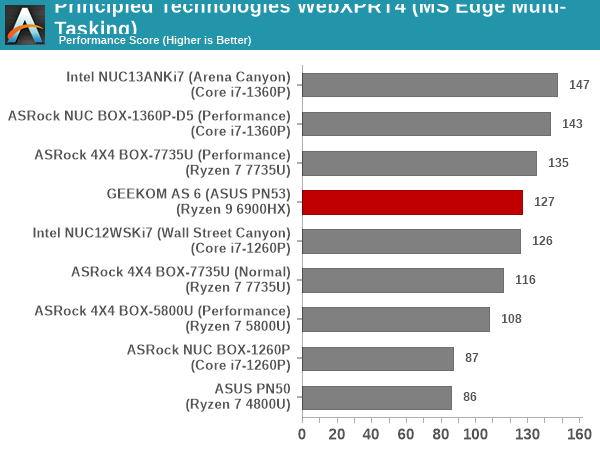
The RPL-P systems had come out on top in the browser benchmarks, and the addition of background loading doesn't change the relative ordering of the systems. The GEEKOM AS 6 continues to remain in the middle of the pack.
The final workload tested as part of the multitasking evaluation routine is CINEBENCH R23.
| 3D Rendering - CINEBENCH R23 Load Testing - Single Thread Score | |||
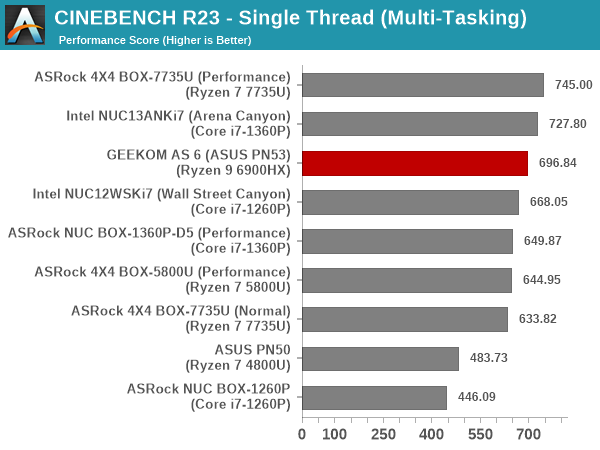
| 3D Rendering - CINEBENCH R23 Load Testing - Multiple Thread Score | |||
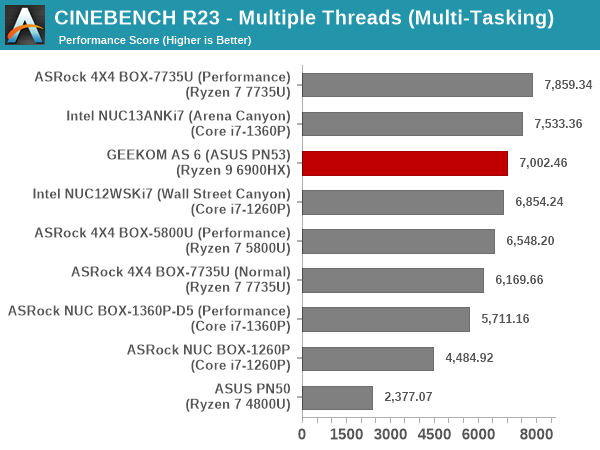
Intensive background tasks keep the efficiency cores busy, and take up some of the power budget. As a result, while the RPL-P systems came out on top in the absence of the background loads in both ST and MT modes, the Rembrandt systems manages to outwit them in raw scores after the introduction of the load.
After the completion of all the workloads, we let the transcoding routine run to completion. The monitored transcoding rate throughout the above evaluation routine (in terms of frames per second) is graphed below.
The transcoding rate during different segments is also recorded below.
| GEEKOM AS 6 (Ryzen 9 6900HX) ffmpeg Transcoding Rate (Multi-Tasking Test) | |||
| Task Segment | Transcoding Rate (FPS) | ||
| Minimum | Average | Maximum | |
| Transcode Start Pass | 3 | 13.8 | 44 |
| PCMark 10 | 0 | 12.02 | 42 |
| WebXPRT 4 | 3 | 12.27 | 22.5 |
| Cinebench R23 | 2 | 12.73 | 39 |
| Transcode End Pass | 4.5 | 13.59 | 40.5 |
The comparison is against RPL-P systems such as the NUC BOX-1360P/D5. The GEEKOM AS 6 has a much lower delta in the transcoding rate between different task segments, but that translates to a lower primary workload score as seen in the graphs above. Overall, the RPL-P systems seem to prioritize foreground task better compared to Rembrandt-based systems such as the GEEKOM AS 6.


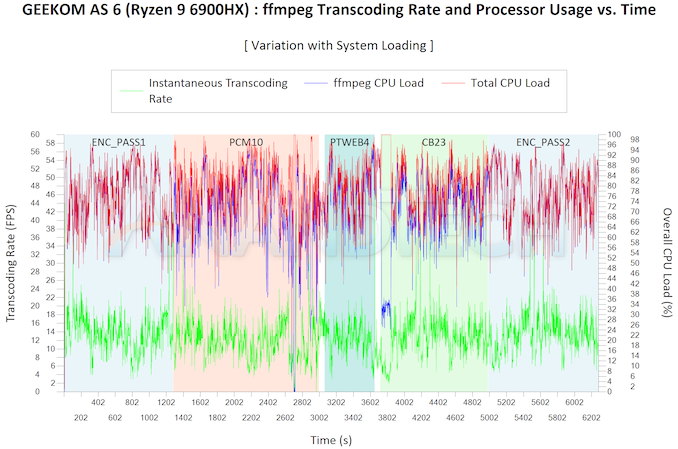








14 Comments
View All Comments
MTEK - Monday, July 31, 2023 - link
HDMI 2.0 and not 2.1. It's 2023. Why is this still happening?nandnandnand - Monday, July 31, 2023 - link
It's a previous-gen part, for one.Does it even need the features or bandwidth of HDMI 2.1?
shabby - Monday, July 31, 2023 - link
First, the beelink gtr6 with the exact sand cpu supports hdmi 2.1Second it was released just last year.
Third, yes I do need all that bandwidth.
Fourth... Just because.
heffeque - Monday, July 31, 2023 - link
They reviewed a fairly "old" mini-PC.All 7040HS mini-PCs have HDMI 2.1
Drkrieger01 - Monday, July 31, 2023 - link
The more 'features' a product has, the more it is likely to cost. Just because a chipset supports a features, doesn't mean it will have it in the product. It may require more electronic components to make the 'feature' functional, which translates to higher product cost overall (or the company may blame that).Also, with an integrated chipset, what is it that you plan to run at the bandwidth of HDMI 2.1? This unit will likely only play video, not games at that resolution/refresh rate.
Drkrieger01 - Monday, July 31, 2023 - link
Also, DisplayPort 1.4a is capable of 4K@96Hz, 8K@30Hz. HDMI 2.0 can only do 4K@60Hz. DisplayPort 1.4a is far superior to HDMI 2.0.meacupla - Monday, July 31, 2023 - link
That is an oddly complex daughterboard.That is the fattest and longest ribbon cable I have ever seen in a miniPC or laptop.
And it seemingly doesn't have to be that long, if the daughterboard wasn't attached to the base that opens up like a clam shell.
rUmX - Monday, July 31, 2023 - link
No AV1 video encoding benchmarks? I think SVT-AV1 should be included. H264/H265 are now ancient codecs.AdrianBc - Tuesday, August 1, 2023 - link
None of these older integrated GPUs support AV1 encoding in hardware.AV1 encoding is supported now in the AMD Phoenix Ryzen 7040 series and it will be supported in the Intel Meteor Lake Core Ultra series, which will be launched by the end of the year.
There already are many models of small computers with Ryzen 7 7840U, Ryzen 7 7840HS or Ryzen 9 7940HS, which support AV1 encoding in real time of several video streams in parallel.
meacupla - Tuesday, August 1, 2023 - link
Mobile Ryzen 6000 only has AV1 decode.